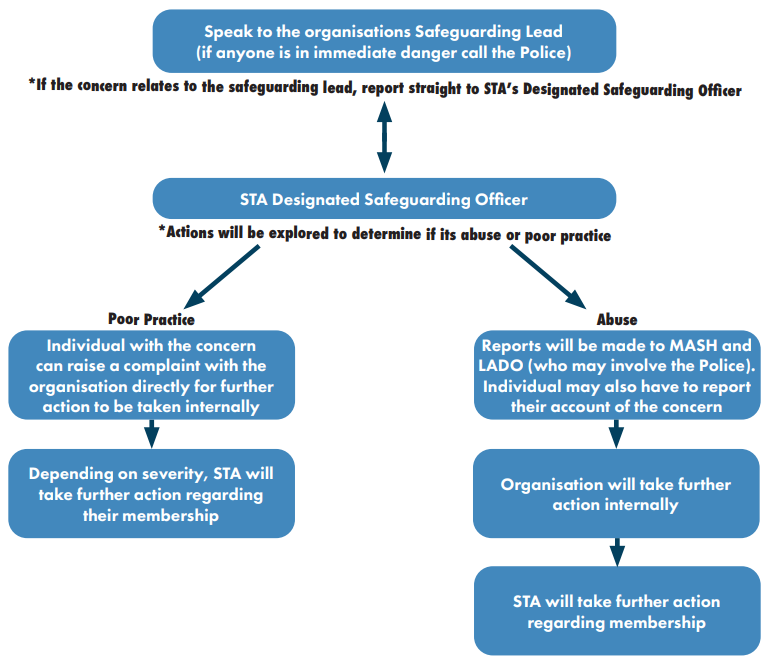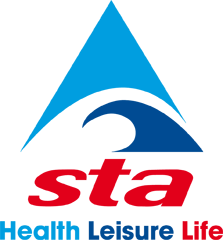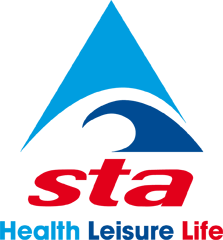STA acknowledges the help provided by the National Society for the Prevention of Cruelty to Children (NSPCC) in producing this policy.
For all questions and concerns please contact our Designated Safeguarding Officer (DSO):
+44 (0)1922 748642*
* Available 08:00-16:00 GMT, Mon-Fri.
National Society for the Prevention of Cruelty to Children (NSPCC) child protection helpline (24/7 service):
0808 800 5000
Victims of abuse can seek support from the National Association for People Abused in Childhood (NAPAC):
0808 801 0331
It is widely accepted that it is the responsibility of every adult to safeguard the wellbeing of children and vulnerable adults. Abuse can arouse strong emotions in those facing such a situation and it is important to understand these feelings, you must ensure they do not interfere with your judgement surrounding the necessary action required.
Abuse and poor practice can occur within many situations including the home, school and the sporting environment. Some individuals will actively seek employment or voluntary work with children or vulnerable adults in order to harm them. Everyone working in the leisure sector either in a paid or voluntary capacity, together with those working in affiliated organisations has a role to play in safeguarding the welfare of children and vulnerable adults and promoting good practice.
A swimming teacher, lifeguard, lifesaver, tutor or volunteer may have regular contact with / vulnerable adults and be a very important link in identifying cases where an individual may be at risk or in need. When establishing guidelines, it is important to recognise that the organisation is both morally and legally obliged to provide the highest possible standard of care.
STA recognises the responsibility to:
- Safeguard and actively promote the welfare and safety of children and vulnerable adults
- Take all reasonable and practical steps to prevent harm, abuse, discrimination, or any form of degrading treatment
- Respect and uphold the rights, wishes and feelings of children and vulnerable adults, ensuring their voices are heard and valued.
Child and vulnerable adults protection procedures can:
- Provide essential safeguards for children / vulnerable adults, STA members, staff, volunteers and those within affiliated organisation, ensuring a safe and supportive environment
- Support and uphold the professionalism, integrity, and high standards of practice expected of STA members, reinforcing a culture of safety and responsibility.
We recognise that safeguarding procedures are only as effective as the knowledge, skills and confidence of those who implement them. Therefore, we are committed to:
- Robust and thorough recruitment practices to ensure suitability of those working with children and vulnerable adults
- Provide ongoing support, training and development to equip individuals with the skills needed to uphold safeguarding responsibilities
- Establish clear and effective processes for recognising, responding to, and reporting concerns
- Working together with parents / guardians and other organisations to ensure that the welfare and safety of all remain paramount.
Principles
- The welfare of the child and vulnerable adult is paramount and must always be the primary consideration
- All participants regardless of age, culture, disability, gender, language, racial origin, religious belief or sexual identity have the right to protection from abuse
- All suspicions, concerns and allegations of abuse will be taken seriously; and responded to
- For the purpose of this document, anyone aged 16 years or under is considered a child.
Working in partnership with children and their parents / guardians is essential for the protection of the children.
STA recognises the statutory responsibility of social services to ensure the welfare of children and vulnerable adults and is committed to working together with the Multi-Agency Safeguarding Hubs (MASH) to ensure effective protection and support.
Recognition of Abuse
Even for those with experience in working with child and vulnerable adult abuse, it is not always straightforward to recognise a situation where abuse may occur or has already taken place. STA acknowledges that their staff, whether in a paid or voluntary capacity, are not expected to be experts in identifying abuse. However, they have a duty to act on any concerns. Therefore, STA expects all staff to report any concerns about the welfare of a child / vulnerable adult immediately to the designated person in charge, following the appropriate reporting procedures.
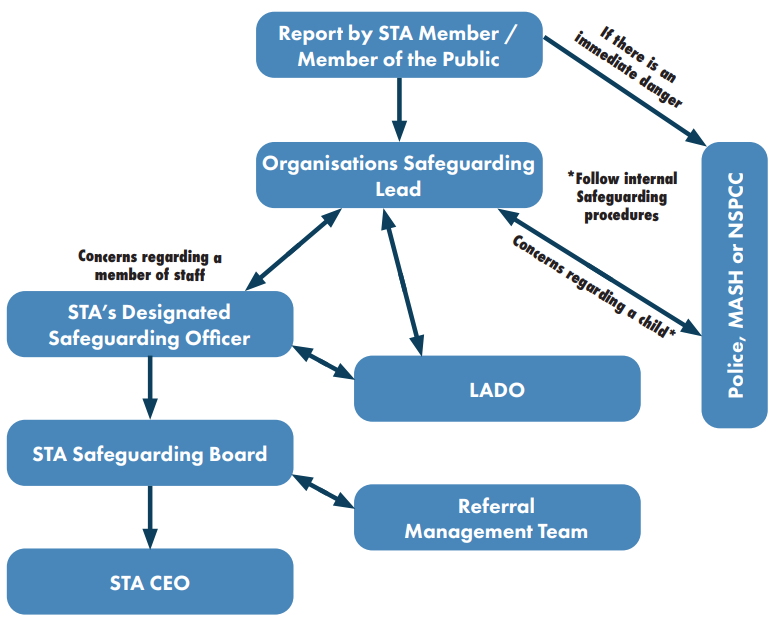
It is the responsibility of these people to ensure that appropriate advice is obtained from the MASH / Local Authority Safeguarding Hub or the NSPCC. If the necessary person is not available, or the concern is about the person in charge, the person in receipt of the information will contact the Social Services direct.
Possible Indications of Abuse in a Child / Vulnerable Adult
- Unexplained or suspicious injuries such as bruising, cuts or burns, particularly in areas of the body not normally prone to such injuries
- Injuries with inconsistent explanations or those that do not match the given explanation
- The child / vulnerable adult describes what appears to be an abusive act involving him / her
- Someone else—a child or adult, expresses concern about the welfare of another child / vulnerable adult
- Unexplained changes in behaviour—e.g. becoming very quiet, withdrawn, or displaying sudden outbursts of temper
- Inappropriate sexual awareness
- Engages in sexually explicit behaviour in games
- Is distrustful of adults, particularly those with whom a close relationship will normally be expected
- Has difficulty in making friends
- Is prevented from socialising with other children
- Displays variations in eating patterns including overeating or loss of appetite
- Loses weight for no apparent reason
- Becomes increasingly dirty or unkempt.
It must be recognised that the above list is not exhaustive and the presence of one or more of the indicators is not proof that abuse is actually taking place. It is not the responsibility of those working in swimming to decide that child abuse is occurring, but it is their responsibility to act on any concerns.
Forms of Abuse
STA recommends adhering to the NSPCC’s updated definition of abuse, the full information can be found here.
The Effects of Abuse
Abuse in all its forms can affect a child or vulnerable adult at any age. The effects can be so damaging, that if not treated, they may follow an individual into adulthood.
There have been a number of studies which suggest children and people with disabilities are at increased risk of abuse through various factors such as stereo-typing, prejudice, discrimination, isolation, and a powerlessness to protect themselves, or to adequately communicate that abuse has occurred. Children from ethnic minorities, who may also be experiencing racial discrimination, may be doubly powerless.
Listening to the Child or Vulnerable Adult
If a child / vulnerable adult says or indicates that they are being abused, or information is obtained which gives concern that a child / vulnerable adult is being abused, the person receiving this information should:
- React calmly so as not to frighten the individual
- Tell them they are not to blame and that it was right to tell someone
- Take what they say seriously, while recognising the difficulties involved in interpreting the words of a very young child, from someone who has a speech disability and / or differences in language
- Limit questions to only what is essential to gain a clear and accurate understanding of what has been disclosed
- Reassure the child, but do not make promises of confidentiality which might not be feasible in the light of subsequent developments
- Make a full record of what had been said, heard and / or seen as soon as possible.
Responding to Suspicions or Allegations of Child Abuse
STA members are NOT responsible for determining if child abuse is taking place. However, they do have a responsibility to report concerns so that appropriate agencies can then make inquiries and take any necessary action to protect the child.
Whilst STA acknowledges the importance of the role of the statutory agencies involved in children’s welfare (social services, police, NSPCC), the importance of using the Multi-Agency Safeguarding Hub (MASH) should not be underestimated. The MASH works with all the statutory agencies and can advise on the best course of action. If a child is in immediate danger, then the police should be contacted.
The MASH may report the incident or disclosure to the social services department which has a statutory duty under the Children Act 1989 to ensure the welfare of a child. When a child protection referral is made its staff have a legal responsibility to investigate. This may involve talking to the child and family and gathering information from other people who know the child. Inquiries may be carried out jointly with the police.
What to Do If There Are Concerns
- There is always a commitment to work in partnership with parents or guardians where there are concerns about their children. Therefore, in most situations, it would be important to talk to parents or guardians to help clarify any initial concerns. For example, if a child seems withdrawn, they may have experienced bereavement in the family.
- However, there are circumstances in which a child might be placed at even greater risk where such concerns are shared, e.g. where a parent or carer may be responsible for the abuse or not able to respond to the situation appropriately.
- In these situations, or where concerns still exist, any suspicion, allegation, or incident of abuse must be reported and recorded to the person in charge as soon as possible.
- It is the responsibility of the person in charge to inform the MASH without delay. If a person in charge is not available, the person discovering or being informed of the abuse should immediately contact the MASH, or the police if a child is in immediate danger. If you’re not sure about what to do, you can contact STA’s Designated Safeguarding Officer (DSO) and / or the NSPCC’s child protection helpline.
Recording and Information
Information that is passed to the social services department, the police or MASH must be as helpful as possible. The information should contain the following:
- The nature of the allegation
- A description of any visible bruising or other injuries
- The child’s account, if he or she can give them, of what has happened and how any bruising or other injuries occurred
- Any times, dates, or other relevant information
- A clear distinction between what is fact, opinion, or hearsay
Reporting the matter to the police or MASH should not however be delayed by attempts to obtain more information. Wherever possible, referrals telephoned to the MASH should be confirmed in writing within 24 hours. A record should also be made of the name and designation of the MASH member of staff or police officer to whom the concerns were passed, together with the time and date of the call, in case any follow-up is needed. If the concern involves an STA member, once the allegation or concern has been raised with the police, MASH or the NSPCC then the concern must be passed on to STA through the DSO.
STA has provided a template Incident Report Form which should be adapted to suit the needs / procedures of the company. This Incident Report Form is to report concerns / disclosures to the company Designated Safeguarding Officer.
Incident Report FormAllegations of Abuse Against Members of STA
Abuse can and does occur outside the family setting. Although it is a sensitive and difficult issue, abuse has occurred within institutions and may occur within other settings, for example, in sport or other social activities. Recent inquiries indicate that abuse, which takes place within a public setting, is rarely a one-off event. It is crucial that those involved in leisure are aware of this possibility and that all allegations are taken seriously and appropriate action taken.
The person in charge may be informed of situations where they are unsure about whether the allegation constitutes abuse or not and are therefore unclear about what action to take. There may be circumstances where allegations are about poor practice rather than abuse. In this instance, those responsible should always consult STA’s DSO and avoid discussions with colleagues as there is a need to protect human rights of all concerned, including the individual against who the allegation is made.
Do not hesitate to gain advice from the Local Authority Designated Officer (LADO). This is important as it may be just one of a series of other instances which together cause concern. It is acknowledged that feelings generated by the discovery surrounding a member of staff or volunteer potentially abusing a child, will raise concerns among other staff or volunteers, including the difficulties inherent in reporting such matters. However, it is important that any concerns for the welfare of the child arising from abuse or harassment by a member of staff or volunteer should be reported immediately.
Where there is a complaint of abuse against a member of staff, there may be three types of investigation:
- A criminal investigation
- A child protection investigation
- A disciplinary or misconduct investigation.
The results of the police and social services investigation may well influence the disciplinary investigation, but not necessarily.
- If, following consideration the allegation is clearly about poor practice, then STA will deal with this as a misconduct issue
- Any suspicion that a child has been abused by a member will be reported to a person in charge who will take such steps as he or she considers necessary to ensure the safety of the child in question and any other child who may be at risk
- The designated person will refer the allegation to the LADO who involve the police
- The parents or carers of the child will be contacted as soon as possible following advice from the social services department
- The person in charge should notify the STA’s DSO
- Every effort should be made to ensure that confidentiality is maintained for all concerned
- If the person in charge is the subject of the suspicion / allegation and is a member of STA, the report must be made to STA’s DSO who is then responsible for taking the action outlined above
- Irrespective of the findings of the social services or police inquiries, STA must assess all individual cases under the appropriate misconduct / disciplinary and welfare procedures, to decide whether a member should be reinstated and how this can be handled sensitively. This may be a difficult decision, particularly where there is insufficient evidence to uphold any action by the police. In such cases, the STA will reach a decision based upon the information that is available which could suggest that on a balance of probability it is more likely than not that the allegation is true. The welfare of children should always remain paramount
- Consideration should be given to what support may be appropriate to children, parents / guardians and members of staff.
Non-Recent Historic Abuse
Allegations of abuse may be made some period of time after the event, and can be:
- An adult making an allegation of abuse when they were under 18 years of age, that occurred at least 1 year before it was reported
- A child making an allegation of abuse that occurred at least one year before it was reported
- Someone reports an allegation, on behalf of someone else, relating to an offence committed over a year ago.
Source: NSPCC (2018)
Such disclosures can occur after long periods of time as the complainant may now feel comfortable that they are no longer at risk, have the confidence to make an allegation that will be believed, become aware that there have been other reports, or feel they need closure to move on. Whatever the motive, and however long ago the allegation, action must be taken because:
- The alleged may not have been an isolated incident
- It may be part of a wider abuse situation
- The person(s) may still be abusing individuals and / or working with children
- There may be on-going legal action.
Source: NSPCC (2018)
Should an allegation or disclosure be made to a member of STA it is important to record and report such information as you would if it were a current situation. The STA maintain extensive records and will support any statutory agency investigating non-recent historic allegations, but please be reassured that all information is stored in line with current data protection and general data protection regulations.
Even though the abuse may have occurred many years ago, the impact may be significant and long lasting. Please reassure the individual that it is not their fault, and that the allegation is taken seriously.
If the individual concerned is confident enough, ask them to call the police non-urgent crimes number on 101 to report the abuse.
If the individual concerned is not confident to call the police, then report the allegation as if it was a current incident, using the available forms. However, please make a note that this is an historic abuse allegation / disclosure.
Support for the victims of abuse can seek support from the NAPAC – the National Association for People Abused in Childhood (NAPAC).
Prevention
All people have a right to be safe and to be treated with dignity and respect.
Basic guidelines will help safeguard both children, staff, volunteers and the organisation concerned and reduce the risk of allegations being made. These are listed below.
Recruitment and Selecting Staff and Volunteers
Anyone may have the potential to abuse children in some way and it is important that all reasonable steps are taken to ensure that unsuitable people are prevented from working with children and vulnerable adults. It is essential the same procedure is used consistently whether staff be paid or unpaid in part-time or full-time occupation.
When undertaking pre-selection checks the following should be included:
- All volunteers and staff working for a swim school, organisation or club should complete an application form
- Application forms should be designed to elicit information about an applicant’s past career (including any gaps), and to establish any criminal record
- Consent should be obtained from applicants for police and social services checks
- At least two references should be provided including at least one regarding previous work with children, and one from a professional that is unrelated to the applicant
- Clubs and employers should have effective measures in place to ensure the confidentiality of information received in relation to applicants is treated with the strictest of confidence
- All volunteers and employees should sign a Child Protection Protocol
- All volunteers and employees should be a checked with the following organisations who maintain information about individuals who are deemed unsuitable to work with children:
- England and Wales
- DBS – 0300 0200 190
- Scotland
- Disclosure Scotland – 0300 020 0040
- Northern Ireland
- Access Northern Ireland – 0300 200 7888
Policy and Procedure
To help prevent abuse of children and vulnerable adults, the swim school, organisation or club should have a policy which ensures that children and vulnerable adults are protected and kept safe from harm. Everyone involved in the care of children should know what to do if there are concerns about abuse and where procedures are kept. STA has created policy templates can be found on STA Online for members (Resources – Guidance Documents) and a webinar to help support with this which can be found below:
Safeguarding WebinarTraining and Seminars
It should be recognised that checks are only part of the process to protect children from possible abuse by members of staff. STA teachers are required to have completed a Safeguarding course, with the STA’s course or an acceptable alternative as determined by STA. They should receive appropriate ongoing training and attend suitable seminars undertaken by experienced deliverers so that they are aware and sensitive to potentially abusive situations.
STA recommend that swimming teachers update their safeguarding training every 3 years, in line with other providers and best practice guidelines.
Complaints and Appeals
The management committee of swim schools, organisations and all clubs will ensure that there is a well-established complaints procedure in operation and that which parents, guardians and children have easy accessibility to.
Position of Trust
A position of trust is a legal term where an adult in certain roles has power of influence over an individual. The law states that an adult, in a position of trust, engaging in any sexual activity with a young person under the age of 18 is a criminal offence. STA members need to be aware that they may be in a position of trust within their roles.
Any misuse of authority, especially involving children / vulnerable adults is a serious breach of safeguarding policies and may have legal consequences. STA recommend adhering to the good practice guidelines outlined below to ensure that professional boundaries are maintained, safeguarding responsibilities are upheld, and the safety and well-being of all participants is prioritised.
STA has taken guidance regarding the position of trust from the NSPCC website here.
Good Practice in the Care of Children
You can reduce situations where the abuse of children may occur and help to protect staff and volunteers by promoting good practice. The following are more specific examples of care, which should be taken when working within a swimming context.
- Always be publicly open when working with children. Avoid situations where a teacher and individual swimmers are completely unobserved
- Where any form of manual support is required, this should be provided openly and with the assent of the child and consent of the parent or guardian. The teacher should also be extremely careful as it is difficult to maintain hand positions when the child is constantly moving. The views of parents / guardians should always be carefully considered
- Where possible parents / guardians should take on the responsibility for their children in the changing rooms. Where classes have to be supervised in the changing rooms, always ensure that teachers work in pairs
- Encourage an open environment, e.g. no secrets
- Do not take children alone in a car on journeys, however short.
And you should never:
- Engage in rough, physical or sexually provocative games, including horseplay
- Share a room with a child
- Allow or engage in inappropriate touching of any form
- Allow children to use inappropriate language unchallenged
- Make sexually suggestive comments to a child even in fun
- Let allegations a child makes go unrecorded, or not acted upon
- Do things of a personal nature that children can do for themselves
- Have children stay at your home with you unsupervised
- Spend excessive amounts of time alone with children away from others
- Take children to your home where they will be alone with you
- Take still or movie photographs of children without obtaining the guardians consent in writing.
It may be sometimes necessary for staff or volunteers to do things of a personal nature for children, particularly if they are young or are children with disabilities. These tasks should only be carried out with a full understanding and written consent of parents and of the children involved. There is a need to be responsive to a child’s reactions and if a child is fully dependent upon you, talk with them about what you are doing and give them choices where possible. This is particularly so if you are involved in any dressing, or undressing of outer clothing, or where there is physical contact of lifting or assisting a child to carry out particular activities.
If during your care of a child you accidentally hurt them, the child seems distressed in any manner, appears to be sexually aroused by your actions, or misunderstands or misinterprets something you have done, report any such incident as soon as possible to another colleague and make a brief written note of it. Parents or guardians should be informed of the incident.
STA acknowledge the help provided by NSPCC in producing these procedures.
What to do if you have concerns about child abuse
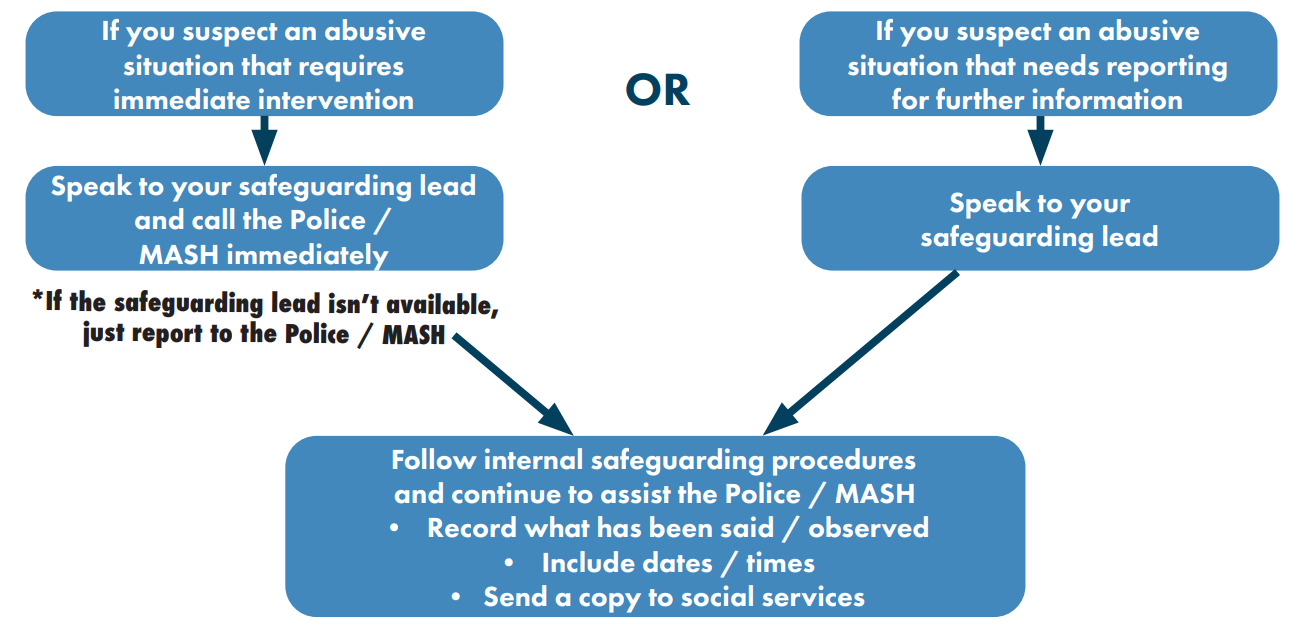
What to do if you have concerns about child abuse by a member of the STA
